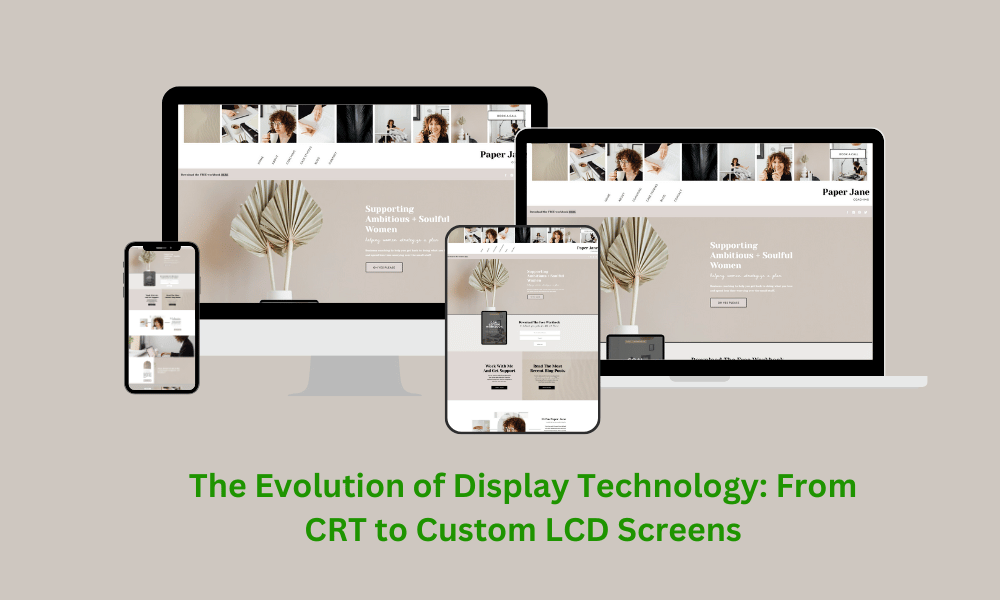Remember the bulky televisions and computer monitors from the past? Those were the days of CRT (Cathode Ray Tube) displays, a revolutionary technology in its time. Fast forward to today, and the screens in our lives are sleeker, clearer, and far more versatile, thanks to the evolution of LCD (Liquid Crystal Display) technology.
This transformation didn’t happen overnight; it’s a story of continuous innovation and improvement, bringing us to the era of custom LCD screens.
The Rise of LCD Screens
The shift from CRT to LCD technology marked a significant milestone in the world of displays. CRTs, which dominated the market for decades, were known for their bulky size and high energy consumption. They worked by firing electrons at a phosphorescent screen, which then emitted light to create images. While effective, this technology had its limitations, especially as consumers demanded thinner, more energy-efficient displays.
Enter LCD screens. These screens use liquid crystals and a backlight to produce images, offering several advantages over CRTs. They are much thinner and lighter, consume less power, and provide sharper images with better color accuracy. This made them ideal for a wide range of applications, from computer monitors to televisions to mobile devices.
The journey of LCD screens began in the 1960s, but it wasn’t until the 1980s and 1990s that they became commercially viable. Early LCDs were primarily used in digital watches and calculators. However, as technology advanced, so did their applications. By the early 2000s, LCD screens started replacing CRTs in personal computers and televisions, marking a new era in display technology.
Custom LCD Screens: Why They Matter
As technology continued to advance, the need for more specialized and versatile display solutions grew. This led to the development of customized LCD screens. Unlike standard LCDs, which are mass-produced with uniform specifications, custom-designed LCD screens are tailored to meet specific requirements. This can involve aspects like size, resolution, shape, brightness, and even touch capabilities.
Why is this important? It allows manufacturers of custom LCDs to create products that are more user-friendly and better suited to specific applications. For example, a tailor-made LCD screen in a medical device can be designed to display critical health information with maximum clarity, while a custom screen in an industrial machine can be built to withstand harsh environmental conditions.
These screens are vital for applications that demand specific performance characteristics. In consumer electronics, this could mean designing screens with higher brightness levels for better outdoor visibility or creating ultra-thin displays for sleek, modern devices. In more specialized fields, they can be designed to endure extreme temperatures, resist dust and moisture, or integrate seamlessly with other technologies.
Applications in Consumer Electronics
One of the most visible impacts is in the realm of consumer electronics. Smartphones, tablets, and laptops are prime examples where custom displays have made a significant difference. These devices require screens that are not only high in resolution but also energy-efficient and durable.
Take smartphones, for instance. Each new generation of smartphones boasts improvements in display technology, often featuring screens designed to enhance the user experience. These customizations can include everything from higher refresh rates for smoother scrolling to better color accuracy for viewing photos and videos. This ensures that consumers are getting the best possible experience from their devices.
Custom LCDs allow manufacturers to design screens that meet these needs while maintaining a slim profile and long battery life, making them more responsive and accurate for demanding tasks.
Industrial and Medical Uses
Beyond consumer electronics, personalized LCD screens are making waves in the industrial and medical fields. In industrial settings, they are used in control panels, monitoring systems, and more. These screens need to be rugged and reliable, capable of operating in challenging environments. Customization allows the creation of displays that meet these stringent requirements.
For instance, in manufacturing plants, tailor-made LCD screens are often used in control systems that monitor and manage machinery. These screens must be durable enough to withstand dust, moisture, and varying temperatures. They also need to provide clear, easy-to-read information to ensure that operators can quickly assess and respond to any issues.
In the medical field, customized LCD screens play a crucial role in diagnostic equipment, patient monitoring systems, and even in surgical displays. These screens need to provide clear, accurate information that can be easily interpreted by healthcare professionals.
Future Trends
The future of display technology is incredibly exciting. As we look ahead, several trends are emerging that promise to push the boundaries of what’s possible.
One such trend is the development of flexible and foldable screens. While still in the early stages, these technologies have the potential to revolutionize the way we interact with our devices. Imagine a smartphone that unfolds into a tablet or a wearable device with a screen that conforms to your wrist. Custom LCD technology is at the heart of making these innovations a reality.
Another trend is the integration of advanced touch and gesture controls. Custom-made LCD screens with built-in sensors can respond to a wide range of inputs, from simple touches to complex gestures. This opens up new possibilities for how we use and interact with technology in our daily lives.
Furthermore, the integration of these screens with other emerging technologies such as augmented reality (AR) and virtual reality (VR) is set to transform various industries. In AR and VR, high-quality, customized displays are crucial for creating immersive experiences. They can be designed to provide the necessary resolution, refresh rate, and color accuracy to support these applications.
In Conclusion
The journey from CRT to LCD screens has been a fascinating one, marked by continuous innovation and improvement. Today’s custom LCD screens are a testament to how far we’ve come, offering tailored solutions that enhance the user experience in countless ways.
As technology continues to evolve, we can look forward to even more exciting advancements in display customization, bringing us closer to a future where our screens are as dynamic and versatile as the world we live in.




Leave A Comment
You must be logged in to post a comment.